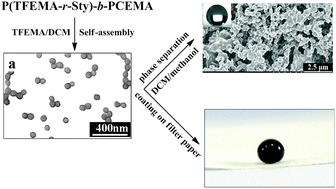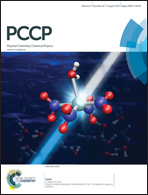Preparation of superhydrophobic films based on the diblock copolymer P(TFEMA-r-Sty)-b-PCEMA†
Abstract
The diblock copolymer poly[2,2,2-trifluoroethyl methacrylate-r-styrene]-block-poly[(2-cinnamoyloxyethyl methacrylate)] [P(TFEMA-r-Sty)-b-PCEMA] was synthesized via atom transfer radical polymerization. The copolymer underwent self-assembly in TFEMA/CH2Cl2 to form spherical micelles. Photo-cross-linking of the PCEMA domains of these micelles yielded cross-linked nanoparticles. The cross-linked nanoparticles were subsequently cast from CH2Cl2/methanol solvent mixtures at methanol volume fractions of more than 30% to yield rough surfaces bearing small nanobumps on micron-sized aggregations that were connected together to form cross-linked nanoparticles. These surfaces were superhydrophobic with a water contact angle of 161 ± 1° and a sliding angle of 6 ± 1°. Spraying these nanoparticles onto substrates exhibiting microscale roughness, such as filter paper, by a traditional coating technique also created superhydrophobic surfaces. A thin layer of nanoscale spherical protrusions was observed on the microscale fibers of filter paper by scanning electron microscopy. The coated filter paper samples exhibited a water contact angle and a sliding angle of 153 ± 1° and 9 ± 1°, respectively.


 Please wait while we load your content...
Please wait while we load your content...